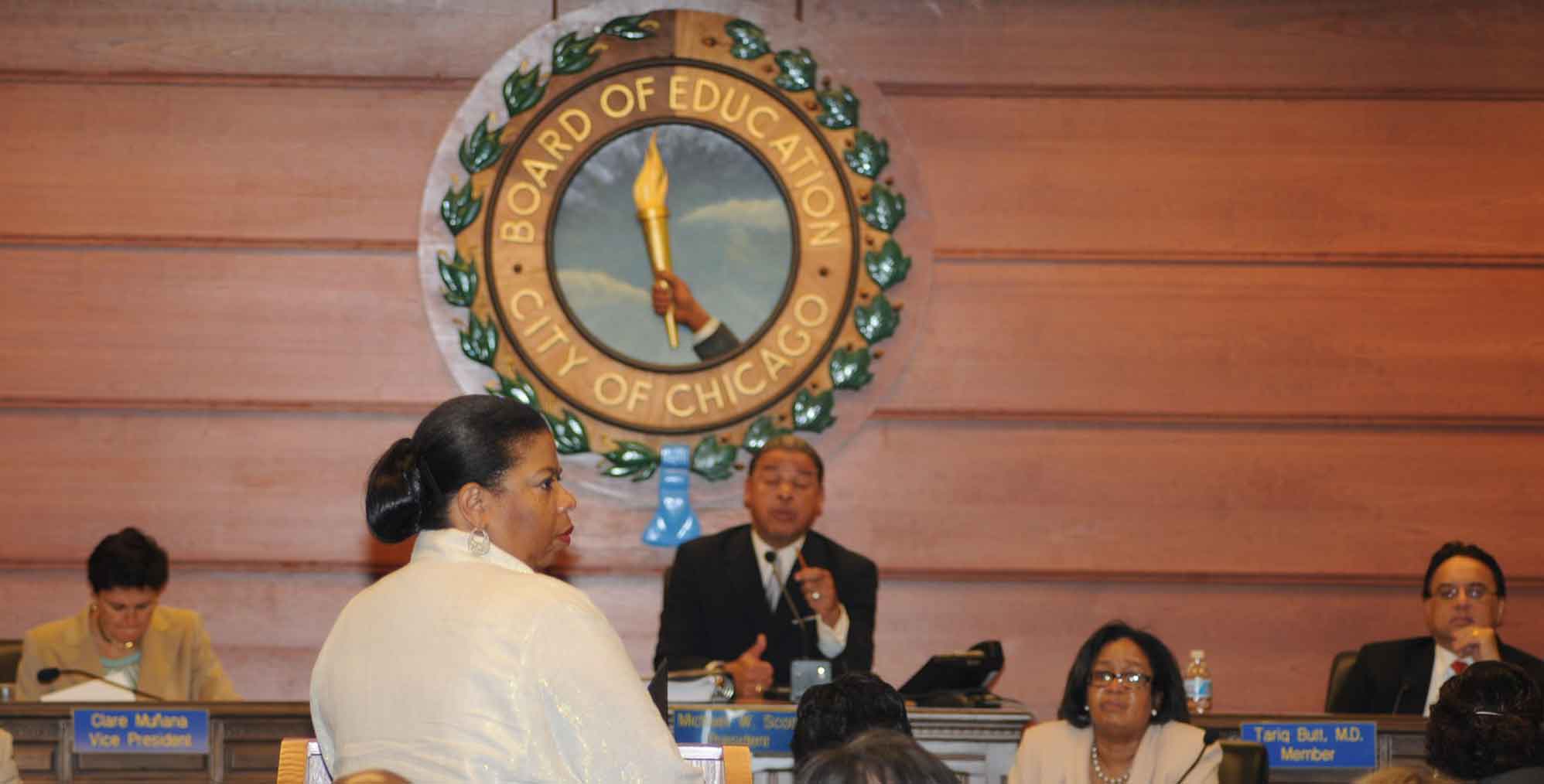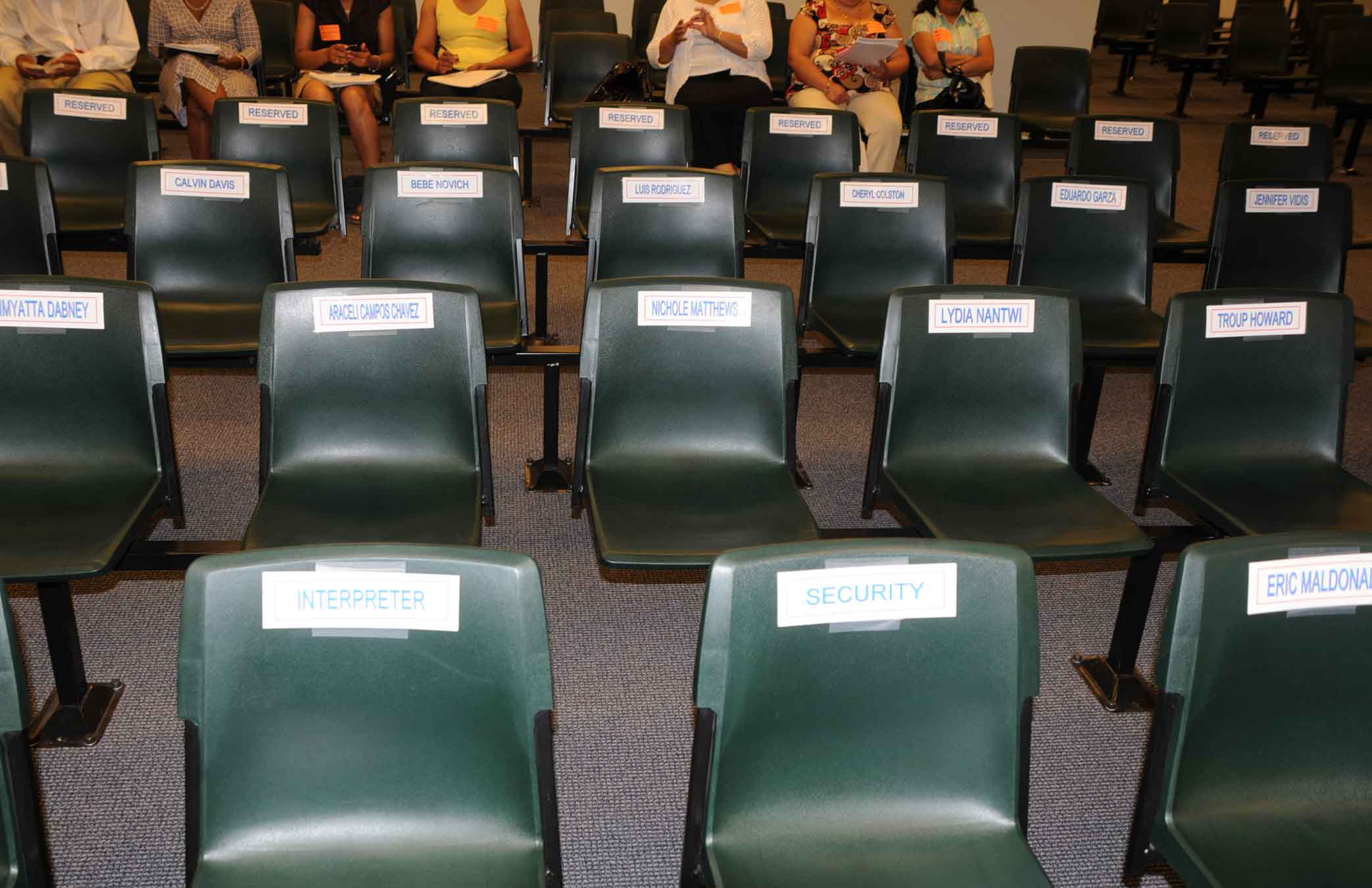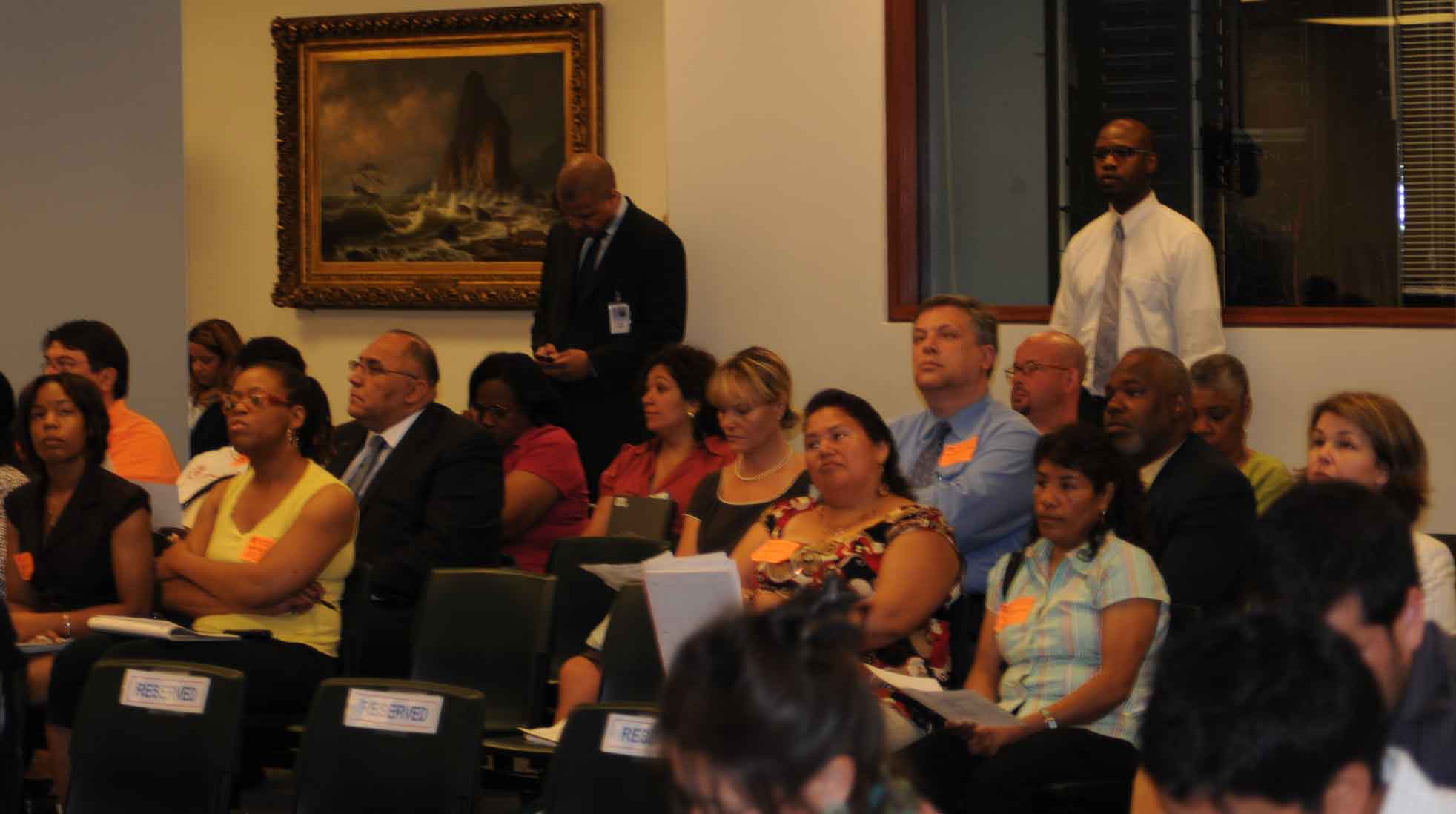Union President Demands Board of Education Meet in the Evening Outside the Loop
Chicago Teachers Union President Marilyn Stewart told the six of seven members of the Chicago Board of Education present at the Board's June 24, 2009, meeting that the Board has to stop meeting in Chicago's expensive Loop during work days and meet in the evenings at locations around the city.
 Chicago Teachers Union President Marilyn Stewart (facing to the right) demanded that the Chicago Board of Education meetings be held during the evenings and at locations across the city where regular people -- including parents, teachers, and students -- could attend. Michael Scott (above, with eyes closed, under Board of Education sign) said he would consider it. Later in the meeting, however, the Board voted that its July 22, 2009, meeting would again be held at the heavily guarded Board of Education headquarters at 125 S. Clark St., three blocks south of Chicago's City Hall. Facing towards the camera in the photo above are (left to right) Board Vice President Clara Munana, Board President Michael Scott (gesturing), "Chief Education Officer" Barbara Eason Watkins, and Board member Tarig Butt. Substance photo by George N. Schmidt.Stewart's demand came during a lengthy presentation to the Board during public participation at the Board's monthly meeting, which was held at its headquarters at 125 S. Clark St. three blocks from Chicago's City Hall. For the past seven years, the Chicago Board of Education has shortened the length of its meetings and refused to meet outside its carefully guarded loop office building at 125 S. Clark St. The Board has never give a reason for the Loop location of the meetings, or for the reason the meetings are held during the work day when most parents and teachers are not able to attend.
Chicago Teachers Union President Marilyn Stewart (facing to the right) demanded that the Chicago Board of Education meetings be held during the evenings and at locations across the city where regular people -- including parents, teachers, and students -- could attend. Michael Scott (above, with eyes closed, under Board of Education sign) said he would consider it. Later in the meeting, however, the Board voted that its July 22, 2009, meeting would again be held at the heavily guarded Board of Education headquarters at 125 S. Clark St., three blocks south of Chicago's City Hall. Facing towards the camera in the photo above are (left to right) Board Vice President Clara Munana, Board President Michael Scott (gesturing), "Chief Education Officer" Barbara Eason Watkins, and Board member Tarig Butt. Substance photo by George N. Schmidt.Stewart's demand came during a lengthy presentation to the Board during public participation at the Board's monthly meeting, which was held at its headquarters at 125 S. Clark St. three blocks from Chicago's City Hall. For the past seven years, the Chicago Board of Education has shortened the length of its meetings and refused to meet outside its carefully guarded loop office building at 125 S. Clark St. The Board has never give a reason for the Loop location of the meetings, or for the reason the meetings are held during the work day when most parents and teachers are not able to attend.
Because of privatized parking, arranged by Mayor Richard M. Daley's brother William Daley, an executive with J.P. Morgan Chase Bank, parents and teachers who wish to park in the privatized parking lots in downtown Chicago have to pay $29 to park for one day.
The last meeting of the Chicago Board of Education to take place outside the Loop was held in April 2002, at the Herzl Elementary School in the Douglas Park community. At that meeting, presided over by President Michael Scott, the Board presented its first three school closings for what it called "academic failure." More than 1,000 angry parents, teachers, and other citizens turned out to denounce the plan, which was Scott's precursor to Renaissance 2010.
Following the April 2002 Board meeting, Scott ordered that the Board meet henceforth at its Loop offices. The building is secured by more than 100 security guards, and parents and teachers who try to attend the meetings are often excluded from the Board chambers (on the fifth floor) and relegated to what are called "holding rooms" on other floors.
 The 5th Floor Board of Education chambers at CPS headquarters in Chicago are small to begin with, with fewer than 200 seats for the public. Prior to each Board meeting, however, Board staff place "Reserved" signs on more than 60 of those seats, including the ones (above) which will appear most often during TV shots of speakers who come before the Board. The Board plans the arrangement of the administrators who sit within camera range on the seats (above) so that they are deployed according to race and ethnicity, showing what Chicagoans called "Mayor Daley's Rainbow" at every point where the Cable TV show of the Board meeting is on TV and focused on a speaker. Above, the "Reserved" seats excluding members of the general public (in background) one half hour before the June 24, 2009, meeting of the Chicago Board of Education. Substance photo by George N. Schmidt.Meanwhile, more than 50 seats in the small meeting room are reserved for mid-level Board of Education administrators and executives, who are carefully placed to fill the seats behind the speakers' podium, so that the TV version of the Board meeting always shows people who are smiling and cheering for the Board and its executives.
The 5th Floor Board of Education chambers at CPS headquarters in Chicago are small to begin with, with fewer than 200 seats for the public. Prior to each Board meeting, however, Board staff place "Reserved" signs on more than 60 of those seats, including the ones (above) which will appear most often during TV shots of speakers who come before the Board. The Board plans the arrangement of the administrators who sit within camera range on the seats (above) so that they are deployed according to race and ethnicity, showing what Chicagoans called "Mayor Daley's Rainbow" at every point where the Cable TV show of the Board meeting is on TV and focused on a speaker. Above, the "Reserved" seats excluding members of the general public (in background) one half hour before the June 24, 2009, meeting of the Chicago Board of Education. Substance photo by George N. Schmidt.Meanwhile, more than 50 seats in the small meeting room are reserved for mid-level Board of Education administrators and executives, who are carefully placed to fill the seats behind the speakers' podium, so that the TV version of the Board meeting always shows people who are smiling and cheering for the Board and its executives.
The deployment of highly paid CPS functionaries in the "Reserved" seats (and often elsewhere during the Board meetings) serves several functions which are obvious to long-time observers. The functionaries who are placed precisely behind the speaker's podium are arranged in a careful array according to race, gender and ethnicity. When a speaker is speaking, they are shown on TV directly behind each speaker, smiling on behalf of the Board of Education. Members of the audience who disagree with the Board are relegated to the sides of the room, out of camera range, or to other floors in "holding rooms" where they are permitted to watch the meeting on closed circuit TV under the eyes of Board Security staff.
 Even in the middle of a meeting of the Chicago Board of Education, the Board's manipulation of the seating in the Board chambers continues. Above, Board security kept the "reserved" seats in the center of the photograph empty nearly two hours after the June 24, 2009, meeting began. The photo above was taken just about noon on the day of the meeting. Additionally, at least two people out of the seventeen seated in the above photograph are CPS administrators, who are often scattered throughout the general public, both to take up seats that could otherwise be used by teachers, parents, and children, and for other purposes. Substance photo by George N. Schmidt.For most of the years between April 2002 and June 2009, Michael Scott was President of the Board of Education. Following the outpouring of public sentiment in opposition to the closing of Dodge, Terrell and Williams elementary schools by Scott and then CEO Arne Duncan at the April 2002 Board meeting, Scott and Duncan insured that the Board would never again meet outside of the location that some people began referring to as the Board's "bunker" — the carefully guarded location where they could hide from the public while pretending to listen to the public in one of the most carefully controlled environments in American public life.
Even in the middle of a meeting of the Chicago Board of Education, the Board's manipulation of the seating in the Board chambers continues. Above, Board security kept the "reserved" seats in the center of the photograph empty nearly two hours after the June 24, 2009, meeting began. The photo above was taken just about noon on the day of the meeting. Additionally, at least two people out of the seventeen seated in the above photograph are CPS administrators, who are often scattered throughout the general public, both to take up seats that could otherwise be used by teachers, parents, and children, and for other purposes. Substance photo by George N. Schmidt.For most of the years between April 2002 and June 2009, Michael Scott was President of the Board of Education. Following the outpouring of public sentiment in opposition to the closing of Dodge, Terrell and Williams elementary schools by Scott and then CEO Arne Duncan at the April 2002 Board meeting, Scott and Duncan insured that the Board would never again meet outside of the location that some people began referring to as the Board's "bunker" — the carefully guarded location where they could hide from the public while pretending to listen to the public in one of the most carefully controlled environments in American public life.
Another method being used more and more now that MIchael Scott has returned as Board President is to limit the time for "public participation" during the meetings. Prior to mayoral control, the public meetings of the Chicago Board of Education took place twice a month, and the Board had between a half dozen and a dozen committees that also met publicly on public business. Since 1995, the Board has abolished its sub-committees, no matter how important the issues. Additionally, the Board only meets once a month, and Michael Scott insists that public participation not extend beyond two hours, no matter how many people are signed up to speak on important public issues. At the Board's May 27, 2009, meeting, Scott abruptly halted the public participation after precisely two hours, leaving six people who had taken the day off from work to attend the meeting without being able to speak.
The cost of attending a Board meeting for the average citizen is not only measured in the cost of a lost day's pay, but by the fact that it costs more than five dollars for most people to take public transportation to and from the Board (Chicago has the most expensive public transit system in the nation) or $29 to park in one of the once public -- but now privatized -- parking lots in downtown Chicago.

